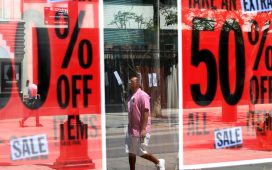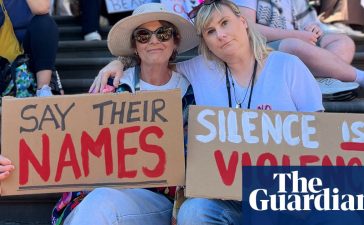There is oodles of lace, glinting diamante and enough sequins for several series of Strictly Come Dancing: no, it’s not the Met Gala but an unassuming street in north London where a quiet battle is under way to protect a hidden fashion treasure.
Almost 100 fashion stores, with names such as Bien Avenue, Cinderella and the sadly now defunct FFUK (short for Fashion Fashion UK) are crammed into about 250m of Fonthill Road, tucked behind Finsbury Park station.
The street was designated a “specialist fashion cluster” by the local council in 2020 to prevent the creeping conversion into flats. However, its retailers are struggling for survival as the area around them rapidly gentrifies, putting pressure on rents and making some of their most loyal customers feel less welcome.
This fashion street has some of the most eye-popping frocks and suits available off the peg and is a far cry from Bond Street, Oxford Street or even hipster favourites such as Brick Lane.
Today, many of the boutiques specialise in wedding dresses and outfits for proms and other special occasions – but mostly at bargain prices.
“Fonthill Road, it’s flamboyant and it is unique,” says Andrew Paschalis, the local economies officer for Islington council. “You are not likely to see dresses like that in many other places.”
“People come with a certain budget and we have to work on very little margin. They wear a dress once for a few hours and then they don’t want to wear it again,” says Suvel Ahmed, the owner of Alia Couture and several other shops on the strip, who sells prom dresses at prices ranging from £100 to more than £600.
Bargain prices could be part of the reason the road flies under most shoppers’ fashion radar, according to Vickie Christensen, the chair of the Fonthill Road traders’ association. “It is the best-kept secret in the fashion world. You can buy a blingy dress for £100. When someone else has spent a fortune on the same kind of thing you are not going to tell anyone. Women don’t.”
The shops are run by entrepreneurs with roots in a plethora of countries, from Cyprus and Turkey to Africa and south Asia.
Shoppers come from a wide variety of backgrounds. Those from cultures where importance is placed on glamorous, dressy weddings, smart church outfits or modest garments that cover limbs and cleavages are particularly drawn to the street. The tailoring skills to cater for those needs are still present here.
People with backgrounds in the Caribbean, Africa and Cyprus or Turkey have long been shoppers alongside those of white British heritage, the Irish Traveller, Middle Eastern and south Asian communities. There are also more recent diaspora, including Afghans, Uzbeks and Latin Americans, scanning the rails.
“It is a microcosm of London. We have every nationality under the sun and it works,” Christensen says. “You get grandmothers and younger ones for prom dresses. You tend to find the whole family comes back to where they have been before.”
Once close to a slum – with local boy photographer Don McCullin describing the area as “a battlefield” when he grew up on Fonthill Road in the 1940s and 50s – it has been part of the fashion industry since the 1960s.
The street was home to shops and light industry from its first development in the 1880s, when one local writer described the preponderance of fried-fish shops.
Its links to fashion emerged when entrepreneurs fleeing Cyprus in the 1960s and 1970s bought property for wholesale outlets and factories. By its heyday in the 1980s Fonthill Road was packed with small manufacturers as well as wholesalers catering to retailers large and small, prompting complaints about double parking and burger vans.
Until the late 1990s, Fonthill would be besieged by shoppers on a Saturday morning when the dozens of small wholesale outlets flung open their doors to the public, who could pick up latest fashions at low prices.
“It was really busy. We used to have five people working on a Saturday,” says Paschalis, whose father had a shop on the street from 1985, under a clothing factory where more than a dozen people worked.
“When it switched from wholesale to predominantly retail that’s when business trailed off.”
John Arpaci, of the wholesaler and retailer Love Fashions, which his father opened on the street in 1966, says: “We are trying to sell stuff you don’t get in M&S, H&M or Zara. We’re more niche.
“We specialise in suits for the office, garden party or church. Traditionally we have done a lot of exports to Africa. The elite came over to purchase and sell on. People buy gifts for mums and aunts.”
Love Fashions makes a small number of its suits locally and Arpaci says: “I would love to see a bit more production in the UK.”
Fonthill Road has suffered a number of blows, the first and biggest of which was when British retailers switched to buying most of their garments from overseas, casting aside small local producers and wholesalers such as those in Fonthill Road.
Since local manufacture and wholesale has largely gone, most Fonthill retailers source their goods from Turkey, with the predominance of wedding outfits emerging about a decade ago.
Christensen said the 2008 banking crisis, the pandemic and rising cost of living have hit hard.
“Covid was the nail in the coffin for a lot of people. They are really struggling,” she says, adding that many are supported by the creation of flats above their shops, with rental income helping to offset the costs for retailers below.
-
Vickie Christensen, the manager of London Fashion Centre, describes the street as the ‘best-kept secret in the fashion world’
“We have lost a few people. People are struggling at the moment and it’s because rents are high but turnover is not high. Banks used to be more flexible on terms. They are not as good at looking after smaller businesses and the problem of gentrification is going on all over.”
Lynda Tarim, of Lynda’s Boutique, says: “We work harder with less profit. I speak to most of my neighbours and many can’t afford the rent.
“I used to have three or four stores and now I have one. I have five staff left and I had about four in each store before. What is the future of this street? In 10 years it is finished.”
Her rent has gone up, and others on the street have experienced even bigger rises as the surrounding area has gentrified, especially since the opening of a giant luxury apartment block as part of the redevelopment of the nearby station, with new chain stores and restaurants including Marks & Spencer and Pret a Manger.
The lengthy building work for that complex also added to pressure on Fonthill Road’s boutiques, and some businesses say it had brought them little benefit.
Ahmed says: “Every year we are seeing a drop, business is declining in terms of sales and profit.
“Everything is changing in terms of restaurants [opening up nearby] but it is not attracting the right sort of customers.
“There is so much competition online. Social media like TikTok and Instagram is destroying our business. Manufacturers in China are selling direct to customers. Retailers are suffering a lot.”
Loucas Agrotis, the owner of the long-established street fashion store Loriana, is more optimistic about the future. He says the arrival of the new flats and restaurants has brought more passing trade and younger people to the area, prompting some different kinds of retailers to open up.
There is also a new buzz created by a nearby project, backed by Islington council and the industry group Fashion Enter, to help foster young designers using local production. The FC Designer Workspace rents out sewing machines and workspaces and also runs workshops on upcycling and garment making. Some of the work is sold via the FC Designer Collective boutique on Fonthill Road.
Agrotis says he would love a return to the buzz of the 1980s: “It was hectic but it was fun.”









